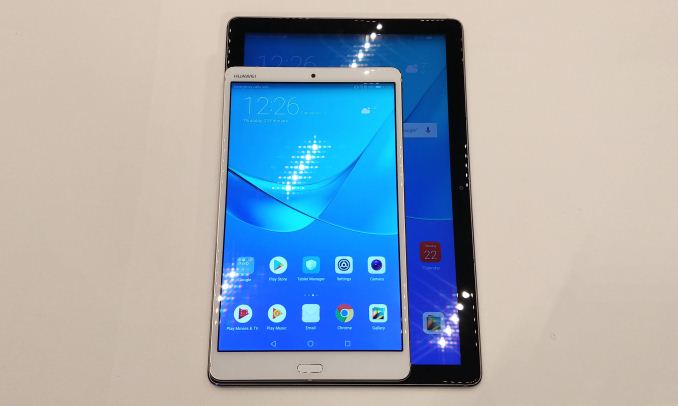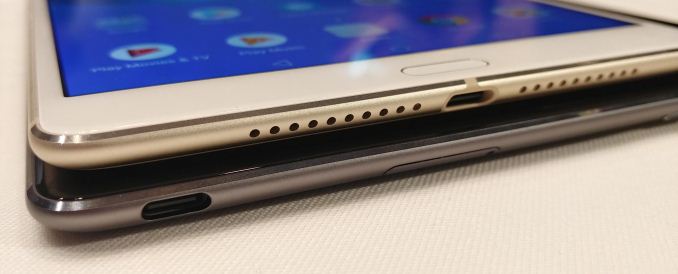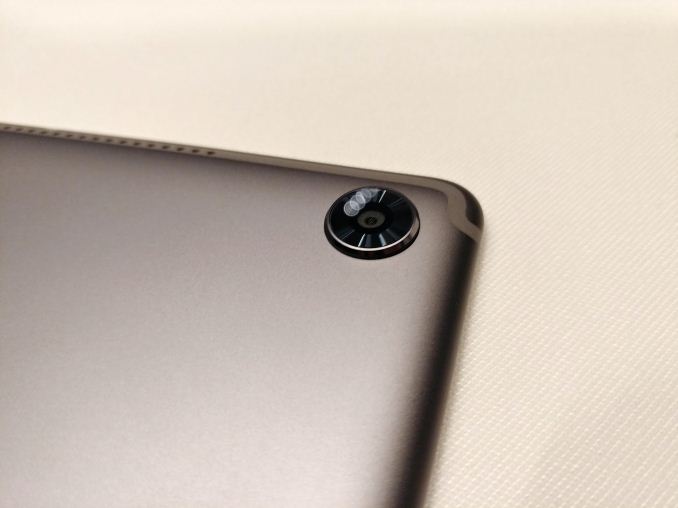New High-End Android Tablets? Huawei MediaPad M5 gets Kirin 960
by Ian Cutress on February 25, 2018 8:30 AM EST- Posted in
- Tablets
- Huawei
- Android
- Trade Shows
- Kirin 960
- MWC 2018
- MediaPad
- MediaPad M5

BARCELONA, ESP – One of the questions we get now and again as AnandTech editors is to suggest what high-end Android tablets a person should buy. The truth of the matter is, aside from the mêlée of Chinese low-end tablets or ones like Alcatel that use quad-A53 processors, there have been no serious updates to this space. Requests are few and far between for something high-end on Android, and the market in the high-end is almost exclusively for iPad devices, especially for a saturated market.
Nonetheless, the questions do come, and several times a year. Huawei is now moving on this market for an updated device for 2018: the MediaPad M5. Available in two sizes, an 8.4-inch display and a 10.8-inch display, one of the key features is going to be the SoC. The Kirin 960 is not the latest flagship SoC, but it is at the heart of Huawei’s Mate 9, Honor 8 Pro, and Honor 9 smartphones, the Huawei flagship devices through most of 2017.
Rather than a jumble of low-speed Arm Cortex A53-cores for both performance and efficiency, and low-end graphics, the Kirin 960 has four high-frequency A73 cores for performance, four A53 cores for efficiency, and a Mali G71 8-cluster GPU solution, using Arm’s BiFrost GPU architecture. The point here is that with sufficient CPU and GPU resources, the MediaPad has to potential to be on par with Huawei’s recent flagship devices for games and audiovisual experiences, rather than most Android tablets which end up as low-end Netflix playback system. The MediaPad devices will also have a dedicated ‘Game Mode’, which extends the internal power/current limits for the SoC graphics and maintains turbo frequencies for longer.
| Huawei MediaPad M5 | ||
| 8.4-inch | 10.8-inch | |
| SoC | HiSilicon Kirin 960 4 x Arm Cortex A73 @ 2.36 GHz 4 x Arm Cortex A53 @ 1.84 GHz |
|
| Graphics | Arm Mali-G71MP8 @ 1037 MHz | |
| Display | 8.4-inch 2560x1600 |
10.8-inch 2560x1600 |
| Storage | 32 GB / 64 GB / 128 GB + microSD up to 256GB |
|
| Memory | 4GB LPDDR4-1866 | |
| Battery | 5100 mAh Up to 11 hours |
7500 mAh Up to 10 hours |
| Wireless | LTE on select mdoels 802.11ac Wi-Fi, Dual Band Bluetooth 4.2 |
|
| Connectivity | Type-C Charging USB Type-C to 3.5mm Audio |
|
| Camera | Rear Camera: 13MP Autofocus Front Camera: 8MP Fixed Focus |
|
| Dimensions | 212.6 x 124.8 x 7.3 mm ~316g |
258.7 x 171.8 x 7.3 mm ~498g |
| Android | Android 8.0 + EMUI 8.0 | |
| Price | TBD | TBD |
For the display, both devices will have a 2560x1600 IPS panel. This means that the 8.4-inch unit will run at 359 PPI and the 10.8-inch unit is at 280 PPI. The display will feature ‘ClariVu’, an enhanced display software technology that manipulates the image through the display buffer to provide ‘a 20% improvement in picture quality’. Huawei did not clarify how this was done or how the metric was measured, as there are many ways to do it, but they confirmed it was a full software solution. The MediaPad M5 will also have a comfort mode that reduces the blue-color intensity. The brightness, contrast ratio, and color accuracy were not reported by Huawei in our briefing.
The MediaPad design is an aluminium unibody construction, with four speakers on the 10.8-inch and two speakers on the 8.4-inch. All the speakers are on the rear, and are co-engineered with harmon/kardon. Huawei is in the process of introducing its Histen surround sound software to its family of products, to which the MediaPad M5 range is an early recipient, with the idea of getting better sound quality through a software package.
The battery capacity of the 8.4-inch device is set at 5100 mAh, which Huawei states is good for 11 hours of 1080p video, and can be charged from flat to full in two hours. The larger 10.8-inch device, due to the backlight requirements of having the same resolution panel but bigger achieve the same brightness, means that the larger 7500 mAh battery supports a shorter battery life: Huawei quotes up to 10 hours of 1080p video, citing a flat to full metric of 3 hours of charging, using the fast charge technology.
The MediaPad M5 will be available in two colors: Champagne Gold and Space Grey. As per previous Huawei launches, pricing will be announced during the official presentation. The key competition to the MediaPad M5 will be the Samsung Galaxy Tab S3, which uses a Snapdragon 820 SoC, launched last year.
The MediaPad M5 Pro
Along with the two ‘regular’ M5 tablets, Huawei is also launching an M5 Pro version. The M5 Pro is the pen-enabled edition of the 10.8-inch M5, and uses Huawei’s latest M-Pen technology. The M-Pen comes in the box of the M5 Pro, and is upgraded over previous M-Pen implementations by being USB Type-C, rather than microUSB. The pen supports 4096 levels of pressure, and will last for 50 days on a full charge.
The other element to the M5 Pro is support for an additional keyboard case accessory, so the tablet can be used with a physical keyboard via the pins in Huawei’s Desktop Mode. This is a similar mode to the desktop mode exhibited with the Mate 10 smartphones, giving a Windows-esque environment and easier access to the file management system.
Again, pricing and availability will be given during Huawei’s launch event.















19 Comments
View All Comments
cmvrgr - Sunday, February 25, 2018 - link
Huawei is for many slaps. The 8” still does not have a flash at the camera, it does not have a earpiece, and is not dual sim. Then they wonders why sales are falling. At the time of the X2 huawei was fantastic. OF course they are doing it in purpose not to cannibalize their smart phone market. We are many that need an 8” tablet with all those features.serendip - Sunday, February 25, 2018 - link
Not many, I'm afraid. The phablet market has indeed cannibalized the Android tablet market so that even Xiaomi have ditched tablets. Now it's the lower-tier manufacturers like Teclast who make cheap Android tablets using common ODM factories.Most of this sad state has to do with Android having few tablet-focused apps in the first place. I used a Lenovo Thinkpad Tablet running Android for years until I switched over to cheap Windows tablets, simply because the apps were terrible. At least Windows tablets can run Win32 programs, even if the app store is a howling wasteland.
StormyParis - Sunday, February 25, 2018 - link
I'm not sure it's quite high end, but the Teclast Master T10 has 2xA73+4xA53, 4GB+64GB+SD, 2560x1600, and everything is quite nice (screen, sound, wifi,n speed, touch sensitivity, OS stability, build...) except I assume the update policy ^^, and the cameras and touchID sensor.I'm happy with mine. It's $200-ish via regular sales on geekbuying. If you can live with iffy service and no updates, it's hard to recommend anything else, bran stuff at that price is a lot less well-specced, and bradn stuff with the same specs is 3x-4x as much. Teclast seem to release crappy and non-crappy tablets alternatively. This is one of the good series; my previous X16 Pro was one of the bad ones ^^
alexdi - Sunday, February 25, 2018 - link
At least one major retailer has the current 9.7" iPad for $270, not to mention a trade-in program for older electronics. This is, to me, the nail in the coffin for 'mid-premium' Android tablets.Roland00Address - Monday, February 26, 2018 - link
Also in the last week two new models of ipad were submitted to the Eurasian Economic Commission for regulatory approval. A1893 and A1954, which do not correspond to any current ipad whether mini, 9.7, or ipad pro.We are likely going to have an ipad announcement in March,
StormyParis - Monday, February 26, 2018 - link
The virality of Apple's ecosystem scares me. The device probably makes sense on its own, but on top of having to re-learn everything, locate the right apps, and buy special cables and doodads, I'd run up again and again into having to change my whole workflow and setup to accomodate Apple's way to do things. Plus I really need a huge storage, and HDMI out is a plus.It's a pity Android tablets have such bad rep and failing suppliers. . Prices are going up on the flagships, and the sensible midrange seems to be deserted. I got Lenovo Yoga Tab Pluses for everyone these last 2 years, should have gotten one for me too since there has been no refresh. I used to find them for $250-ish which is fine, but they're priced like collector items nowadays.
alexdi - Tuesday, February 27, 2018 - link
It's worth the switch. I very much like the customizability of Android, but I don't miss it. Most of the customizations were to compensate for flaws in the platform. The iPad is great out of the box. I'm typing on it now. I've used it a couple hours a day for the last four days and still haven't bothered to charge it. It's extremely well-executed. You're on a generic tablet, but even if you had an S3 or whatever, I'd say the same thing: this is a wildly better product.mrvco - Sunday, February 25, 2018 - link
Google seems to have all but given up on aggressively pursuing the tablet and TV markets for Android.name99 - Sunday, February 25, 2018 - link
And the watch market...UtilityMax - Sunday, February 25, 2018 - link
Ian Cutress, I am sorry, but your post is a complete bullshit. You are suggesting that before now there were no high-end Android tablets, and that the only Android tablets you could have were those using the SoC's using low-end A53 cores. This is of course false. In late 2016 or early 2017 (depending on the market) Huawei introduced the Mediapad M3 tablet. Its SoC was using A72 cores and was on par with Snapdragon 820. Another high end tablet is that Samsung Galaxy S3, introduced last year and using Snapdragon 820 SoC.In fact, the anandtech website should really refrain from judging or recommending tablets since it hasn't posted a tablet review for more than a year. Go stick to your mechanical keyboards and power supplies. Leave the tablets alone since you don't have a whole lot of competency in them to begin with.